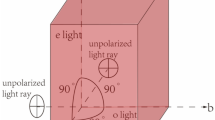Abstract
RECENTLY some ruby, grown by a vapour-phase process, has been found to be orange coloured rather than the normal pink. Some of this has been investigated as a potential maser material by taking a small sample (∼ 10 mg), containing 0.05 per cent Cr3+, double pumping at 23 kMc/s and observing the resulting inversion of the 2–3 transition at 9 kMc/s (Fig. 1). This was then compared with the inversion obtained from a sample of pink ruby of similar size and concentration, placed in the microwave cavity, alongside the orange ruby. The c axes of the two crystals were arranged to be at 90° to each other and at 45° to the radiofrequency magnetic field in order to achieve similar transition probabilities. The inversion ratio I, defined as:  when measured at 1.4° K, was found to be 1.5 for the pink ruby, while that of the orange was much bigger, being of the order of 5.0 for most samples.
when measured at 1.4° K, was found to be 1.5 for the pink ruby, while that of the orange was much bigger, being of the order of 5.0 for most samples.
This is a preview of subscription content, access via your institution
Access options
Subscribe to this journal
Receive 51 print issues and online access
$199.00 per year
only $3.90 per issue
Buy this article
- Purchase on Springer Link
- Instant access to full article PDF
Prices may be subject to local taxes which are calculated during checkout
Similar content being viewed by others
References
Weber, J., Rev. Mod. Phys., 31, 681, appendix (1959).
Scovil, H. E. D., Feher, G., and Seidel, H., Phys. Rev., 105, 762 (1957).
Author information
Authors and Affiliations
Rights and permissions
About this article
Cite this article
JOLLEY, D., MCLAUGHLAN, S. Microwave Inversion Efficiency of Orange Ruby. Nature 199, 898–899 (1963). https://doi.org/10.1038/199898c0
Issue Date:
DOI: https://doi.org/10.1038/199898c0
Comments
By submitting a comment you agree to abide by our Terms and Community Guidelines. If you find something abusive or that does not comply with our terms or guidelines please flag it as inappropriate.



